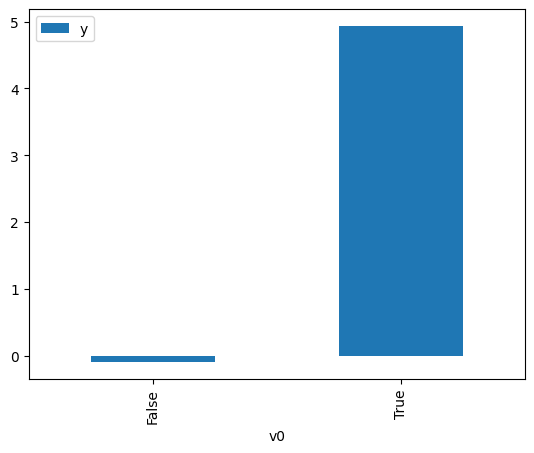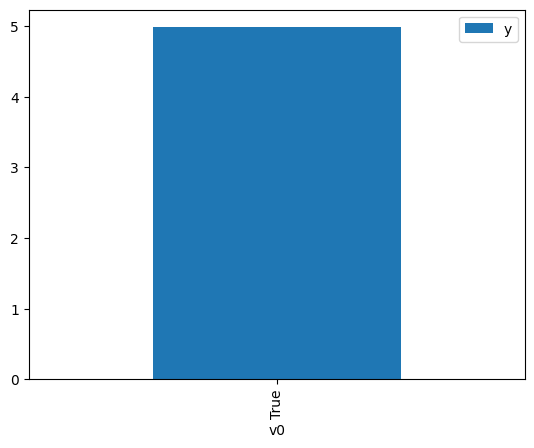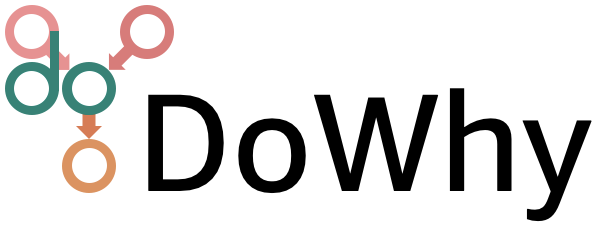Demo for the DoWhy causal API#
We show a simple example of adding a causal extension to any dataframe.
[1]:
import dowhy.datasets
import dowhy.api
from dowhy.graph import build_graph_from_str
import numpy as np
import pandas as pd
from statsmodels.api import OLS
[2]:
data = dowhy.datasets.linear_dataset(beta=5,
num_common_causes=1,
num_instruments = 0,
num_samples=1000,
treatment_is_binary=True)
df = data['df']
df['y'] = df['y'] + np.random.normal(size=len(df)) # Adding noise to data. Without noise, the variance in Y|X, Z is zero, and mcmc fails.
nx_graph = build_graph_from_str(data["dot_graph"])
treatment= data["treatment_name"][0]
outcome = data["outcome_name"][0]
common_cause = data["common_causes_names"][0]
df
[2]:
| W0 | v0 | y | |
|---|---|---|---|
| 0 | -0.269430 | False | 0.362230 |
| 1 | -0.082544 | False | -0.767772 |
| 2 | -1.814006 | False | -0.707189 |
| 3 | -1.449714 | False | -1.707053 |
| 4 | 0.996700 | True | 2.920611 |
| ... | ... | ... | ... |
| 995 | -1.426200 | False | -1.152158 |
| 996 | 0.799952 | True | 5.970946 |
| 997 | 0.336987 | True | 7.368024 |
| 998 | -1.835364 | False | -0.493349 |
| 999 | 0.007103 | True | 4.539431 |
1000 rows × 3 columns
[3]:
# data['df'] is just a regular pandas.DataFrame
df.causal.do(x=treatment,
variable_types={treatment: 'b', outcome: 'c', common_cause: 'c'},
outcome=outcome,
common_causes=[common_cause],
).groupby(treatment).mean().plot(y=outcome, kind='bar')
[3]:
<Axes: xlabel='v0'>

[4]:
df.causal.do(x={treatment: 1},
variable_types={treatment:'b', outcome: 'c', common_cause: 'c'},
outcome=outcome,
method='weighting',
common_causes=[common_cause]
).groupby(treatment).mean().plot(y=outcome, kind='bar')
[4]:
<Axes: xlabel='v0'>

[5]:
cdf_1 = df.causal.do(x={treatment: 1},
variable_types={treatment: 'b', outcome: 'c', common_cause: 'c'},
outcome=outcome,
graph=nx_graph
)
cdf_0 = df.causal.do(x={treatment: 0},
variable_types={treatment: 'b', outcome: 'c', common_cause: 'c'},
outcome=outcome,
graph=nx_graph
)
[6]:
cdf_0
[6]:
| W0 | v0 | y | propensity_score | weight | |
|---|---|---|---|---|---|
| 0 | 0.678214 | False | 0.638137 | 0.377125 | 2.651638 |
| 1 | 0.790310 | False | -0.069697 | 0.358504 | 2.789370 |
| 2 | 0.641499 | False | -0.379419 | 0.383307 | 2.608872 |
| 3 | 0.031219 | False | -0.845857 | 0.490134 | 2.040257 |
| 4 | 0.090265 | False | -0.439085 | 0.479597 | 2.085085 |
| ... | ... | ... | ... | ... | ... |
| 995 | -0.001491 | False | -0.046452 | 0.495976 | 2.016226 |
| 996 | -0.504713 | False | -0.992955 | 0.585034 | 1.709302 |
| 997 | -0.092837 | False | -1.266626 | 0.512291 | 1.952015 |
| 998 | -1.253501 | False | -0.125889 | 0.706513 | 1.415403 |
| 999 | -1.231512 | False | 0.477721 | 0.703244 | 1.421981 |
1000 rows × 5 columns
[7]:
cdf_1
[7]:
| W0 | v0 | y | propensity_score | weight | |
|---|---|---|---|---|---|
| 0 | 0.112066 | True | 4.564782 | 0.524290 | 1.907342 |
| 1 | -1.671744 | True | 4.628525 | 0.235528 | 4.245780 |
| 2 | 0.679911 | True | 6.201627 | 0.623159 | 1.604726 |
| 3 | -1.633031 | True | 5.480536 | 0.240545 | 4.157226 |
| 4 | 0.003191 | True | 7.543041 | 0.504860 | 1.980747 |
| ... | ... | ... | ... | ... | ... |
| 995 | 0.186091 | True | 3.327907 | 0.537462 | 1.860597 |
| 996 | 0.533387 | True | 5.117317 | 0.598275 | 1.671472 |
| 997 | -0.211352 | True | 3.773451 | 0.466586 | 2.143230 |
| 998 | -0.150743 | True | 5.005458 | 0.477378 | 2.094776 |
| 999 | -1.568709 | True | 6.005801 | 0.249041 | 4.015404 |
1000 rows × 5 columns
Comparing the estimate to Linear Regression#
First, estimating the effect using the causal data frame, and the 95% confidence interval.
[8]:
(cdf_1['y'] - cdf_0['y']).mean()
[8]:
$\displaystyle 5.22492144239524$
[9]:
1.96*(cdf_1['y'] - cdf_0['y']).std() / np.sqrt(len(df))
[9]:
$\displaystyle 0.091787074923842$
Comparing to the estimate from OLS.
[10]:
model = OLS(np.asarray(df[outcome]), np.asarray(df[[common_cause, treatment]], dtype=np.float64))
result = model.fit()
result.summary()
[10]:
| Dep. Variable: | y | R-squared (uncentered): | 0.920 |
|---|---|---|---|
| Model: | OLS | Adj. R-squared (uncentered): | 0.920 |
| Method: | Least Squares | F-statistic: | 5714. |
| Date: | Sat, 15 Nov 2025 | Prob (F-statistic): | 0.00 |
| Time: | 06:22:50 | Log-Likelihood: | -1429.1 |
| No. Observations: | 1000 | AIC: | 2862. |
| Df Residuals: | 998 | BIC: | 2872. |
| Df Model: | 2 | ||
| Covariance Type: | nonrobust |
| coef | std err | t | P>|t| | [0.025 | 0.975] | |
|---|---|---|---|---|---|---|
| x1 | 0.1671 | 0.031 | 5.380 | 0.000 | 0.106 | 0.228 |
| x2 | 5.0148 | 0.047 | 106.327 | 0.000 | 4.922 | 5.107 |
| Omnibus: | 0.243 | Durbin-Watson: | 1.959 |
|---|---|---|---|
| Prob(Omnibus): | 0.885 | Jarque-Bera (JB): | 0.320 |
| Skew: | -0.024 | Prob(JB): | 0.852 |
| Kurtosis: | 2.927 | Cond. No. | 1.52 |
Notes:
[1] R² is computed without centering (uncentered) since the model does not contain a constant.
[2] Standard Errors assume that the covariance matrix of the errors is correctly specified.
